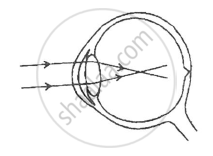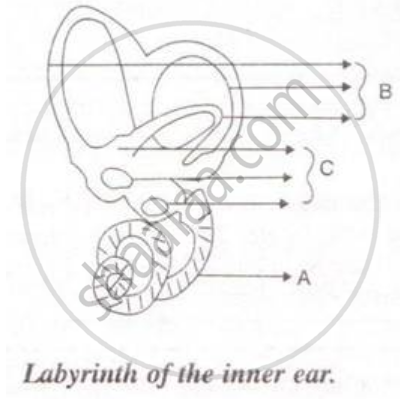Advertisements
Advertisements
प्रश्न
Given below is the diagram of the human ear. Study the diagram and then answer the questions that follow:

(i) What role does the eardrum play in hearing?
(ii) What common term is given to the parts labeled A, B, and E?
(iii) Would there be any difference if these three parts mentioned in (ii) above were replaced by one by one? Why?
(iv) Give the biological term for the parts labeled C and D.
(v) Name the fluid which fills the parts mentioned in (iv) above.
(vi) State the functions of the ear.
उत्तर
(i) The eardrum is vibrated by sound waves and passes them to the internal ear.
(ii) Ear ossicles.
(iii) One big ossicle would not be able to produce effective amplification because it would require a greater force of vibration that supplied by the eardrum normally. Moreover, three smaller ossicles with proper distance between their produce multiple amplification and effective transmission.
(iv) C is semi-circular canals and D is the cochlea.
(v) Endolymph.
(vi) Hearing and balancing of the body.
APPEARS IN
संबंधित प्रश्न
Given below is a diagram depicting a defect of the human eye, study the same and then answer the questions that follow:

(i) Name the defect shown in the diagram.
(ii) What are the two possible that cause this defect?
(iii) Name the type of lens used to correct this defect.
(iv) With the help of a diagram show how the defect shown above is rectified using a suitable lens.
(i) Draw a well labelled diagram of the membranous labyrinth found in the inner ear.
(ii) Based on the diagram drawn above in (i) give a suitable term for each of the following descriptions :
1. The sensory cells that helps in hearing.
2. The part that is responsible for static balance of the body.
3. The membrane covered opening that connects the middle ear to the inner ear.
4. The fluid present in the middle chamber of cochlea.
5. The structure that maintains dynamic equilibrium of the body.
State the exact location of the Organ of Corti
What is the function of ear ossicles?
Give scientific reasons: We cannot distinguish colours in moonlight.
Perilymph or endolymph (Which one surrounds the organ of Corti ?)
State whether the following statements are true (T) or false (F). If false, correct them by changing any one single word in each.
Semi-circular canals are concerned with static (positional) balance.
Given below is certain structure. Write against them its functional acivity.
organ of corti and ……………….
Where is the Cochlea located? Briefly mention its function.
With reference to the human ear, answer the question that follow:
Give the technical term for the structure found in the inner ear.
Draw a labelled diagram of the inner ear.
How could you convince a small child that when you speak, it is not necessary for air to travel from you mouth to the ear of listener?
Draw a neat and labelled diagram of the human ear. With the help of this diagram, explain the construction and working of the human ear.
Given below is a diagram of a part of the human ear. Study the same and answer the question that follow:

Name the parts labeled A, B and C in the diagram.
Name the following:
The ear ossicle in contact with the oval window of the inner ear.
Verify experimentally the laws reflection of sound.
The eardrum is known as ______.
Note the relationship between the first two words and suggest the suitable word/words for the fourth place.
Semi-circular canal : Ampulla :: Cochlea : ______.
Where are the following located?
Eustachian canal
Name the part of the inner ear that is responsible for static balance in human beings.
